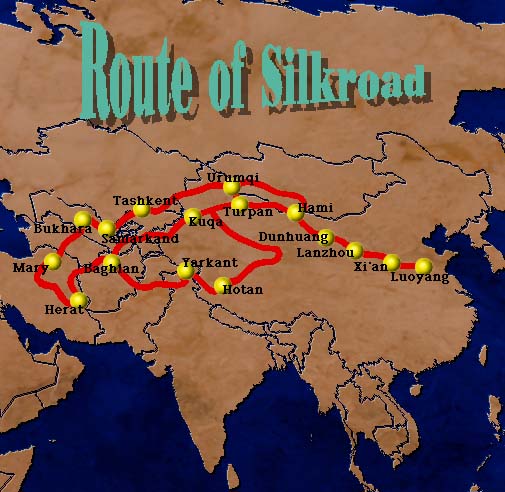Although assumed by many to be a single road, the Silk Road is actually a combination of a series of routes. The road actually developed into a series of routes all beginning at the Chang'an, the ancient capital of Han. The silk route served as a trade connection to Western Civilizations, and was a major part of the Han Dynasty's sucess. The routes all started from the capital in Changan, headed up the Gansu corridor, and reached Dunhuang on the edge of the Taklimakan.
The northern route then passes through Yumen Guan (Jade Gate Pass) and crossed the neck of the Gobi desert to Hami (Kumul), before following the Tianshan mountains round the northern fringes of the Taklimakan. It passed through the major oases of Turfan and Kuqa before arriving at Kashgar, at the foot of the Pamirs. The southern route branches off at Dunhuang, passing through the Yang Guan and passing through the southern edges of the desert, Miran, Hetian (Khotan) and Shache (Yarkand), then turned north again to meet the other route at Kashgar. There were many other routes that were not used as often.One of them branched off from the southern route and headed through the Eastern end of the Taklimakan to the city of Loulan, before joining the Northern route at Korla. Kashgar became the new crossroads of Asia; from here the routes again divided, heading across the Pamirs to Samarkand and to the south of the Caspian Sea, or to the South, over the Karakorum into India; a further route split from the northern route after Kuqa and headed across the Tianshan range to eventually reach the shores of the Caspian Sea.
[1] Northern route - Westward to Black Sea
[2] Central route - Westward to Persia, Mediterranean Sea, Rome
[3] Southern route - Westward to Afghanistan, Iran, India
[4] Eastward to Sian

(map depicting branches of Silk Road)
There were also a series of sea routes that can be considered part of the Silk Road because during the Han Dynasty Chinese ships traded with Southeast Asian Kingdoms. Also many important scientific and technological ideas migrated along the Silk Road to the West. These ideas and inventions included gunpowder, the magnetic compass, the printing press, silk, mathematics, ceramic and lacquer crafts. Musical forms and instruments traveled the Silk Road also. String, wind, and percussion instruments from both East and West influenced each other. The Persian mizmar, a reed instrument, seems to be an ancestor of the European oboe and clarinet. Cymbals were introduced into China from India and Chinese gongs traveled to Europe.
The Silk was not only used for the transportaion of silk, but was also used by merchents to transport many other different types of goods. Caravans heading towards China carried gold and other precious metals, ivory, precious stones, and glass, not manufactured in China until the fifth century. In the other direction furs, ceramics, jade, bronze objects, lacquer and iron were carried. Many of these goods were bartered for others along the way, and objects often changed hands several times.
The Silk Road, however, did pose a problem for the Han Dynasty. Because of the tranporttion of many luxourious goods, the Silk Road faced the threat of theives and invasions. Because merchants were being raded, the Han Empire had to develop ways to protect those traveling on the Silk Road from foreign barbarians or theives. Part of the Great Wall was built near the Silk Road in order to protect it from northern invaders. Those traveling on the road, traveled in large caravans with armed guards, for protection.